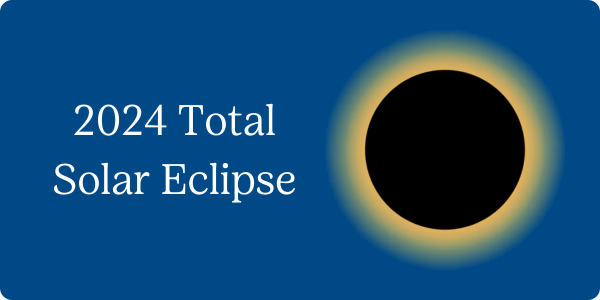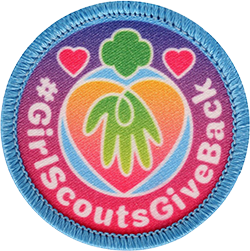
April 8, 2024, is a big day here in the US. A total solar eclipse will cross North America! This eclipse is especially important because it is the last time a solar eclipse will pass through North America until 2098 - 74 years from now. This eclipse allows us to learn more about space science and light up our Girl Scout’s interest in the solar system and universe.
We’ve highlighted some information and resources below to help Troop Leaders and parents prepare for this extraordinary event:
What is a solar eclipse?
A solar eclipse occurs when the moon passes between the Earth and the Sun. The moon temporarily blocks out the sun, creating a shadow on the surface of the Earth. From our perspective, the sun is blocked out and it becomes completely dark. For more info and helpful pictures, check out our free eclipse info sheet.
How do we view the eclipse safely?
First, you need to get a pair of eclipse viewing glasses. These glasses are NOT normal sunglasses- they are much darker. When you put on a pair of eclipse glasses, you won’t be able to see anything except for the sun. You should wear these glasses at all times when you are viewing the sun, except for the few minutes when the sun is totally dark in the path of totality. If you order the GSGATL eclipse kit, you’ll receive a pair of eclipse glasses!
If you don’t have eclipse glasses, you’ll need to view the sun indirectly. You can easily create a pinhole projector, like this one from NASA’s Goddard Space Flight Center.
NASA also provides extensive safety information!
What will we see in Georgia?
When talking about solar eclipses, scientists often reference the “path of totality.” This is the path that the moon’s shadow falls on the earth. People standing in this path will see a total solar eclipse. If you are outside this path, you’ll see a partial eclipse; the sun won’t be completely blocked at any point.
The April eclipse’s path of totality will pass through Texas, Arkansas, Kentucky, Illinois, Indiana, Ohio, upstate New York, and Maine. Here in Atlanta we’ll see 75-80% totality, which is enough to notice a darkening of the sky in the middle of the day. Northern Georgia will see closer to 85%, while southern Georgia is closer to 70%. You can download NASA’s map to find out more.
In Atlanta, the partial eclipse will start at 1:45 p.m. The moon will gradually move to cover the sun until about 3:04 p.m., when it will be at its maximum. Then the sun will slowly be uncovered until 4:20 PM.
Be sure to keep a close eye on the weather forecast- seeing the sun on a cloudy day is difficult! If it is partially cloudy out, you might be able to catch glimpses through the clouds. The eclipse will be streamed online from various locations, just in case the sky is cloudy here.
How is this eclipse different from the one in October?
October’s eclipse was an Annular Eclipse. This type of eclipse happens when the moon is at its furthest point (apogee) from Earth and appears much smaller than the sun. This is a little complicated, but we explain it in detail on our eclipse info sheet.
In April, the moon will appear to be about the same size as the sun and will cover it fully. This is a strange astronomical coincidence! The sun is about 400 times larger than the moon, but the sun is also about 400 time farther away. Because of that, they often appear to us to be the same size!
How should we celebrate this eclipse?
There are so many options and opportunities for your Girl Scouts to celebrate and learn more! First, consider planning a few different space science activities in the weeks prior to the eclipse so that your Girl Scouts know what to expect and why its so cool. Check the Space Science badges for your Girl Scout level on the VTK for some ideas or use GSGATL’s eclipse kit for inspiration!
If your Girl Scouts are out of school on Monday, April 8, you can host a viewing party! This is another opportunity to do some badge activities (or fun experiments), while observing the eclipse with your solar glasses. Consider some extra ways to celebrate, with space-themed snacks, decorations, or games!
If your Girl Scouts are in school during the eclipse, reflect and wrap up on their experiences afterwards. Ask them to think about the next eclipse in 74 years. How old will they be, and what will the world be like? This could be a fun creative activity- draw a self-portrait or make a collage in response to these questions!
How can we incorporate badges into our eclipse viewing?
The Space Science badges are the obvious ones to earn, and there are activities for these badges in the GSGATL Eclipse Kit. If your Girl Scouts have already earned these, think outside the box! We’ve dropped a few hints below:
- Automotive Design (Daisy, Brownie, Junior): Have your Girl Scouts design a vehicle for use on the moon. What special features will it need?
- STEM Career Exploration (all levels): Explore different jobs that support missions to space, or research space science! Mission Control, NASA engineers, astronomers, astrophysicists- all of these professions are busy learning things during a solar eclipse.
- Outdoor Art (all levels): create eclipse-inspired artwork! Notice how your local environment changes during the eclipse and use that to create artwork.
How can we incorporate badges into our eclipse viewing?
- Free eclipse info sheet
- GSGATL Eclipse Kit
- Camp Timber Ridge Think Like a Citizen Scientist Journey Day April 6
- Camp Meriwether All Things Astronomy April 5-7


 Get outside. Days are shorter and getting colder, but fresh air and exercise is good for physical and mental wellbeing.
Get outside. Days are shorter and getting colder, but fresh air and exercise is good for physical and mental wellbeing.  Limit College Talk. As stressful as you find the process, your child is feeling it even more. Adults mean well when they ask teens questions like “Where did you apply” or “Have you gotten in?” The reality might be the teen wasn’t accepted or is waitlisted to their top choice, maybe their college decision is based on whether or not financial aid comes through or maybe they aren’t sure if their post-high school plans include college. At holiday gatherings, head off stress-inducing questions by letting friends and family know it’s a long process and the family should know something in the next few months.
Limit College Talk. As stressful as you find the process, your child is feeling it even more. Adults mean well when they ask teens questions like “Where did you apply” or “Have you gotten in?” The reality might be the teen wasn’t accepted or is waitlisted to their top choice, maybe their college decision is based on whether or not financial aid comes through or maybe they aren’t sure if their post-high school plans include college. At holiday gatherings, head off stress-inducing questions by letting friends and family know it’s a long process and the family should know something in the next few months. Lend a helping hand. Studies indicate helping others makes us feel good about ourselves. December is a perfect time to work on a community project.
Lend a helping hand. Studies indicate helping others makes us feel good about ourselves. December is a perfect time to work on a community project.  Don’t overschedule. There’s lots to see and do during school holidays, but being constantly in the car and on the go can raise anxiety in some kids. Check-in with your Girl Scout to see how they are feeling and be willing to scale back plans, if necessary. Staying home and reading a good book, playing with a family pet, listening to music, or even taking a nap may be something your child needs to decompress.
Don’t overschedule. There’s lots to see and do during school holidays, but being constantly in the car and on the go can raise anxiety in some kids. Check-in with your Girl Scout to see how they are feeling and be willing to scale back plans, if necessary. Staying home and reading a good book, playing with a family pet, listening to music, or even taking a nap may be something your child needs to decompress.

 Download the free
Download the free  Juniors can earn the
Juniors can earn the  Ready to rodeo?
Ready to rodeo? 
 Take the
Take the  Become a
Become a  Are you looking for area adventures? Check out our
Are you looking for area adventures? Check out our  Finally, don’t forget to check out Girl Scouts Love State Parks weekend September 9, 10 for a variety of activities hosted by
Finally, don’t forget to check out Girl Scouts Love State Parks weekend September 9, 10 for a variety of activities hosted by 










 3. Connect with Friends and Family - According to doctors, supportive relationships increase your sense of belonging and purpose, boost happiness and reduce stress. This summer, set up a time for your girl to get together with members of her troop to play, be silly, and catch up with each other. Encourage her to try a new hobby like photography, woodworking, or anime illustration. Bring her and the family to one of our
3. Connect with Friends and Family - According to doctors, supportive relationships increase your sense of belonging and purpose, boost happiness and reduce stress. This summer, set up a time for your girl to get together with members of her troop to play, be silly, and catch up with each other. Encourage her to try a new hobby like photography, woodworking, or anime illustration. Bring her and the family to one of our  4. Connect with Community - Mental health experts agree helping others gives us purpose and creates a sense of well-being. In the Girl Scout Law, we promise to “make the world a better place” and summer is a great time to put that Law into action. Ask your girl what she’s passionate about and help her find a way to turn that passion into purpose. For example, does she love animals? Maybe she can collect towels or newspapers for the local shelter. If she’s completed the prerequisites, she can learn more about the Girl Scout High Awards at our Silver, Bronze, and Gold Award summer academies. Here, with girls her own age, she can spend the day developing a take-action project for the upcoming Girl Scout year. Previous Girl Scout High Awards include building a little library, running a water safety course, creating a used musical instrument donation for students at a Title 1 school, and designing a mural along the Atlanta Beltline. Visit
4. Connect with Community - Mental health experts agree helping others gives us purpose and creates a sense of well-being. In the Girl Scout Law, we promise to “make the world a better place” and summer is a great time to put that Law into action. Ask your girl what she’s passionate about and help her find a way to turn that passion into purpose. For example, does she love animals? Maybe she can collect towels or newspapers for the local shelter. If she’s completed the prerequisites, she can learn more about the Girl Scout High Awards at our Silver, Bronze, and Gold Award summer academies. Here, with girls her own age, she can spend the day developing a take-action project for the upcoming Girl Scout year. Previous Girl Scout High Awards include building a little library, running a water safety course, creating a used musical instrument donation for students at a Title 1 school, and designing a mural along the Atlanta Beltline. Visit 
